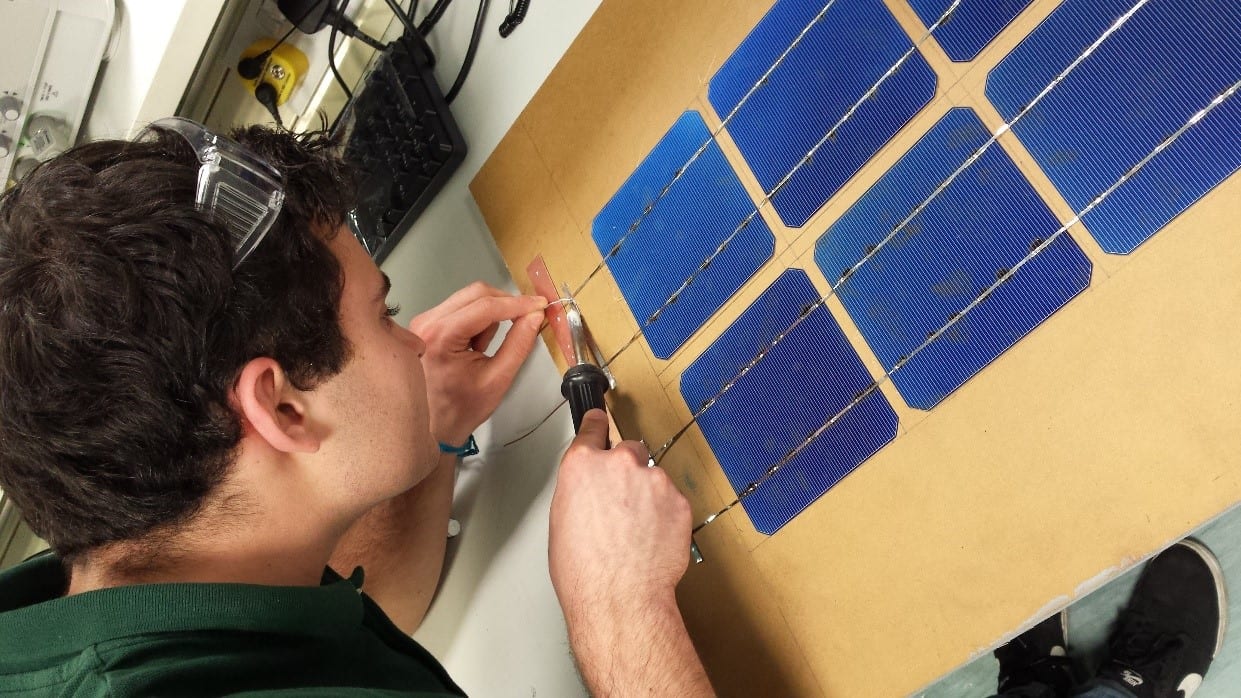Have you ever thought of harnessing the power of the sun to energize your home or gadgets? Making a small solar panel might seem daunting, but it’s absolutely achievable with a bit of time and the right materials. Not only can it help save on electricity bills, but it’s also a fantastic way to delve into renewable energy. In this guide, we’ll walk you through the simple steps to create your very own solar panel. Get ready to tap into the sun's exciting potential!
Materials Needed

Before diving into the actual project, it’s important to gather all the necessary materials. Having everything at hand will make the process a lot smoother and more enjoyable. Here’s a comprehensive list of what you’ll need to create your small solar panel:
- Solar Cells: These are the heart of your solar panel. You can buy them from online retailers or local electronics stores. A typical small panel requires around 36 cells.
- Glass Sheet: Use a thin sheet of glass to cover your solar cells. This protects them from weather and dust while allowing sunlight to pass through effectively.
- Plywood or PVC Board: This will serve as the base for mounting your solar cells. Choose a sturdy material that can handle outdoor conditions.
- Soldering Kit: You’ll need a soldering iron and solder to connect the solar cells. Make sure to have some practice if you're new to soldering!
- Wires: Use quality wiring to connect the solar cells and the output terminal. Look for wires that have a good current carrying capacity.
- Sealant or Epoxy: To seal the edges of your solar panel and keep moisture out, a good sealant is a must.
- Multimeter: This handy tool will help you measure the power output of your solar panel once it's assembled.
- Safety Gear: Don’t forget goggles and gloves to protect yourself while working!
With these materials in hand, you’re all set to start your DIY solar panel project! Remember, careful preparation and attention to detail are key for a successful build.
3. Step-by-Step Instructions
Creating your own solar panel might sound daunting, but with the right materials and a little patience, it's entirely possible! Let’s break down the process into manageable steps to make it as simple as pie.
- Gather Your Materials:
Before diving into construction, make sure you have everything you need. Here's a quick checklist:
- Solar cells (Monocrystalline or Polycrystalline)
- Glass or Plexiglass sheet
- Wooden or aluminum frame
- Tabbing wire and soldering iron
- Diodes
- Multimeter
- Sealant
- Prepare the Frame:
Your frame will hold your solar cells. Cut the wood or aluminum to form a rectangle that fits your glass sheet. The dimensions will depend on how many cells you're using.
- Arrange the Solar Cells:
Lay the solar cells on the glass sheet according to your desired configuration, ensuring they aren't touching each other. Many DIYers suggest a series configuration for easier connections.
- Solder the Cells:
Use the tabbing wire to connect the cells in series. Soldering can be tricky, so take your time! Make sure all connections are secure.
- Seal It Up:
Once all cells are connected, place the glass on the frame and seal it with your chosen sealant to protect against weather conditions.
- Test Your Panel:
Finally, grab that multimeter! Test your new solar panel's voltage and ensure everything is working as it should. If it’s not, double-check your connections.
4. Connecting the Solar Panel
Connecting your homemade solar panel to your desired setup is a crucial part of the process. Whether you want to power a light bulb or charge a battery, how you connect it matters. Let’s walk through the instructions for a successful connection!
- Choose Your Controller:
For efficient energy usage and to protect batteries, use a solar charge controller. This device regulates the flow of electricity from the solar panel to the battery, preventing it from overcharging.
- Connect the Solar Panel to the Charge Controller:
Attach the positive and negative leads from your solar panel to the corresponding inputs on the charge controller. It’s essential to match the colors:
Lead Color Connection Type Red Positive (+) Black Negative (-) - Connect the Charge Controller to the Battery:
Once your solar panel is hooked up to the charge controller, it's time to connect the controller to your battery. Again, match the colors:
- Red wire to Positive (+)
- Black wire to Negative (-)
- Test Everything:
After everything is connected, check the battery's voltage with your multimeter. If all is well, you’ve successfully connected your solar panel!
Now that your DIY solar panel is both assembled and connected, you’re on your way to harnessing the power of the sun!
5. Testing Your Solar Panel
Once you’ve put in the effort to create your very own solar panel, it’s time to see if it’s functioning as you intended. Testing your solar panel isn’t just a technical step; it’s the moment of truth that shows just how effective your DIY project has been. Here’s how to go about it:
- Gather Your Tools: You'll need a multimeter to measure the voltage and current output of your solar panel.
- Pick the Right Time: Test your panel on a sunny day. The sunlight will significantly influence your panel's performance.
- Set Up Your Multimeter: Set your multimeter to the DC voltage setting. Connect the leads to the output wires of your solar panel: red to positive and black to negative.
- Measure Voltage: With your multimeter connected, check the voltage reading. Make sure it aligns with the specifications of your solar cells.
- Test Under Load: To see how your panel performs under real-world conditions, connect it to a small load (like a light bulb). Measure the current output using the multimeter set to DC current.
After testing, jot down your findings. If the readings are below your expectations, double-check your connections and the quality of the solar cells you used. A little troubleshooting can make a big difference!
6. Maintenance Tips
Just like any DIY project, maintaining your solar panel is key to ensuring it operates efficiently for a long time. Here are some simple maintenance tips to keep your solar panel in top-notch condition:
- Regular Cleaning: Dust, dirt, and debris can block sunlight and reduce efficiency. Clean your panels every few months with water and a soft cloth. Avoid harsh chemicals!
- Check for Damage: Periodically inspect your solar panels for any cracks, loose wires, or other signs of wear and tear. Address any issues immediately to prevent more extensive damage.
- Inspect Connections: Ensure all connections are tight and corrosion-free, especially in areas prone to moisture.
- Keep an Eye on Performance: Regularly check the output of your solar panel to ensure it’s generating power as expected. Any significant drop might indicate a problem that needs addressing.
- Store Properly (if applicable): If you plan on moving or storing your solar panel, make sure to keep it in a dry, safe place to avoid damage.
With just a bit of care and attention, your DIY solar panel will serve you well, powering up your devices and lighting up your life! Happy solar power adventures!
How to Make a Small Solar Panel With This Simple DIY Guide
Creating a small solar panel can be a rewarding project that provides you with renewable energy at home. Whether you want to power small devices or light up your garden, this simple DIY guide will help you construct your own solar panel with easily sourced materials.
Here’s a step-by-step process to build a small solar panel:
Materials Needed:
- Solar cells (monocrystalline or polycrystalline)
- Soldering iron and solder
- Glass or acrylic sheet (for protection)
- Wooden frame or an enclosure
- Wiring (16-gauge wire recommended)
- Diodes (to prevent backflow of current)
- Multimeter (to measure voltage and current)
Step-by-Step Instructions:
- Prepare Your Solar Cells: Handle the solar cells carefully to avoid breaking.
- Solder the Cells: Connect the solar cells in series or parallel by soldering them together using a soldering iron.
- Construct the Frame: Build a wooden frame large enough to hold the solar cells, and ensure it is weather-resistant.
- Secure the Cells: Attach the cells to the backing material using silicone adhesive to ensure they are secure and insulated.
- Connect the Wires: Solder wires to the connections on the solar cells and attach a diode to prevent current backflow.
- Install Your Panel: Place the glass or acrylic sheet over the solar cells for protection and secure it to your frame.
- Testing: Use a multimeter to test the voltage and ensure everything is functioning properly.
By following these steps, you can create your own small solar panel and contribute to a more sustainable way of living. Enjoy the benefits of harnessing solar energy with this easy DIY project!
Conclusion
With just a few materials and some basic tools, you can make your own small solar panel, allowing you to tap into renewable energy sources while embracing eco-friendly practices.
 admin
admin








